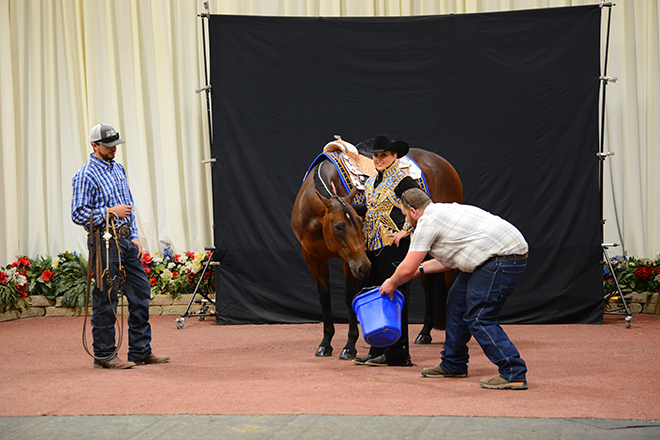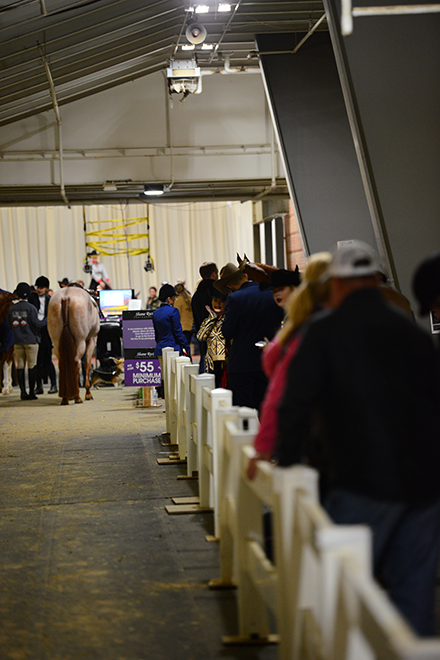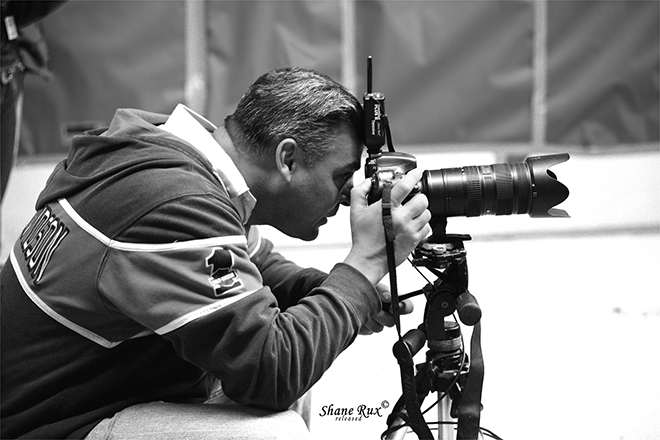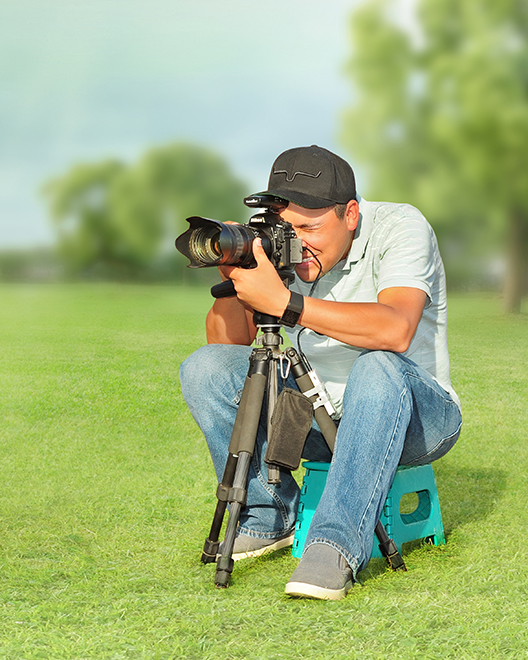
Photographs are the memories that last forever.
They can be brought back out 10 years after the horse show for a good laugh. Photos capture an amazing moment in time and bring it to life.
Most shows have an official photographer dedicated to produce those high-quality photos. There are two locations you can usually find the official photographer of the show: in the arena or at the backdrop. The backdrop is the space set up with curtains, flowers and carpet where the typical “win” photos are taken.
To make your photo experience smoother, here are some tips from professional photographers in the industry, Shane Rux, Jeff Kirkbride and Cody Parmenter.
Be Prepared
One of the most important parts of getting a win photo taken is being prepared upon arrival. The rider, horse, family and friends need to be ready to go once they are in line. Rux and Kirkbride recommend running through a checklist and being ready when it’s your turn.
“They need to bring everything,” Rux said. “People, awards, grooming supplies and anything else they want in their photo should be with them. When they arrive at the backdrop they need to make sure the horse is properly groomed. They also need to take a headcount to make sure all the people they want in the photo are present.”
Jeff Kirkbride aims to make sure competitors have something to remember the moment by.

“I want that photo to take you back to that joy you felt when it happened,” he said. “Take a moment to think how you would like to look in this rendering and how you’d like your trusty steed to appear, as well as your friends. Dust things off, including your friends, clean off your horse’s feet, your boots and tuck your friend’s shirt in. The trick is do all this while there are people ahead of you in line.”
The photographers prepare to ensure their crew provides an easy and fun procedure for exhibitors when they come take their backdrop win photo. They also want to be fair when it comes to standing in line.
“To expedite the process, exhibitors will have to be courteous and allow people in line behind them to move in front if they aren’t 100% ready to go when it is their turn,” Rux said. “This helps prevent long durations of waiting between customers.”
There are multiple pose options for customers to choose from. Take time and review your options so you can better communicate to the photographer what it is you want to photographically achieve. If you have any questions be sure to ask the person checking you in or the photographers themselves.
Be Aware
Signs are posted all around the backdrop area for multiple reasons. These signs inform customers about where to go, minimum purchase prices, show specials, policies and more. The most important to read is the minimum purchase price. This means every time you step on the backdrop carpet a minimum price must be paid. Each pose is another fee. This includes adding or removing people, horses, objects, etc. Kirkbride and Rux further explained this strategy.

“The backdrop is a posed photo,” Kirkbride said. “There is a fee due for that. In my case the price of an 8×10 print is included with your pose fee (i.e. we will wrestle with your horse and ribbons if you’re willing to buy an 8×10). Customers need to understand that all photographers have their backdrop this way with a minimum purchase cost for each pose.”
Multiple shots are taken to provide a range of options.
“It isn’t set up like a session with unlimited poses for one price,” Kirkbride said. “There are also different poses that can vary in cost due to the extent of graphics and editing needed. An example would be a portrait style photo with a black background. This requires more attention to detail because it is a close-up shot.”
The other important signs to read are the ones indicating no cell phone photos or other camera photos being allowed at the backdrop. The backdrop is proprietary to the photographer.
“Please don’t try to sneak a photo at the backdrop or in the arena after a professional has spent many years learning the trade and many dollars on the help that is at the show trying to provide that great memory for you,” Kirkbride said.
Various associations have policies that allow champions, sponsors, show officials or others to come straight to the front of the line. These people need to quickly go back to their jobs during the show. Exhibitors need to be informed of these policies to avoid the frustrations and misunderstandings when they are in line.

“Be aware of policy procedures that are posted around the backdrop area,” Rux said. “Our goal is to be efficient and fair to all exhibitors and customers while following the rules.”
Photographers are taking a high risk financially at every show. They’ve already tied up an extensive amount of capital in hotel reservations, travel costs, internet and payroll prior to the start of the show. They start out in a financial deficit. This is also barring any emergency costs with equipment during the show.
“Photographers are similar to vendors because they provide a service to the show and aren’t paid by the show itself,” Rux said. “Some show contracts also require sponsorships towards that specific show. By the end of the show we hope our financial risk will be worth the financial reward. It is always a gamble and sometimes there is financial loss overall. Some shows have proven to not be profitable. Chances are if you don’t see an official photographer at smaller circuit shows it is not due to the lack of photographers, it is because those shows can’t be justified financially.”
Be Patient
The bigger the horse show, the more photos are being taken. This means the production side of the business will take longer. Photographers spend essential time on every photo so they can create the best product for each person. Every photo is essentially customized to be exactly what they want. Parmenter knows from years of experience how thorough the editing process can be.
“We are always happy to take a photo for a customer that they like enough to purchase, and we can be proud to put our name on,” he said. “That’s the goal. From that point, people often don’t realize that there is still a fair amount of work to be done before that picture ends up in their hands or inbox. In the Instagram and Facebook influenced world we live in now, people increasingly want their photos on demand. I’ve spent 20 years helping people get their photos as efficiently as possible. Unfortunately, for a quality product, processing time and some patience on the customer’s part is necessary. Once we ask for that, and people realize we all have the same goal – to get great photos in a timely manner – people are usually understanding and a little more compassionate to the fact that we’re dealing with an enormous workload after the shows.”

The graphic design aspect of the business has reached an amazing level. Photographers are able to offer numerous edits to a photo if you let them know to put it on hold before the image is worked up. Putting that order on hold for changes does however put it at the bottom of the stack to be completed. The bulk of photos are taken towards the end of the show. The higher volume times are like lunch hour rushes and will have a longer wait time.
“Generally, any edits to a photo (changing backgrounds, fixing ears, tails, etc.) will take longer than ordering straight images,” Parmenter said. “People may not realize the amount of intricate work that goes into making it look right or not obviously photoshopped. In some ways that’s a good thing as I’ve spent a lot of time trying to be not only quick but good at it. Cutting anything out of a photo is still a tedious task that involves more time. The same goes with adding awards to a win photo. Many people think that since they took their photo the first week, but brought back the awards the last day, that they are still chronologically ahead of everyone, but it’s unfair to everyone who got their photo taken in the meantime with no additional editing required.”
The photography crew is doing its best to ensure every person goes home with an incredible photo to commemorate your experience at the show. They understand exhibitors and horses are very tired by the time they arrive at the backdrop, but the photographer and staff have also been at the show from the very beginning until the end every day. Remember to be courteous and always ask any questions you may have before the photos are taken.



You must be logged in to post a comment Login